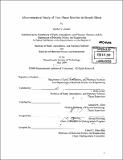| dc.contributor.advisor | J. Brian Evans and Samuel M. Allen. | en_US |
| dc.contributor.author | Zucker, Rachel V. (Rachel Victoria) | en_US |
| dc.contributor.other | Massachusetts Institute of Technology. Dept. of Materials Science and Engineering. | en_US |
| dc.date.accessioned | 2010-09-02T14:57:30Z | |
| dc.date.available | 2010-09-02T14:57:30Z | |
| dc.date.copyright | 2009 | en_US |
| dc.date.issued | 2009 | en_US |
| dc.identifier.uri | http://hdl.handle.net/1721.1/58189 | |
| dc.description | Thesis (S.B.)--Massachusetts Institute of Technology, Dept. of Materials Science and Engineering; and, (S.B.)--Massachusetts Institute of Technology, Dept. of Earth, Atmospheric, and Planetary Sciences, 2009. | en_US |
| dc.description | Cataloged from PDF version of thesis. | en_US |
| dc.description | Includes bibliographical references (p. 48-52). | en_US |
| dc.description.abstract | Microstructural and textural observations have been conducted on synthetic calcite with 20 wt% quartz deformed in simple shear using transmission electron microscopy and selected-area diffraction. The marbles were deformed at 873, 973, and 1073 K at a stress of 305, 222, and 127 MPa, respectively, and a strain rate of 10 -4 s -1. The microstructure, shape-preferred orientation (SPO), grain aspect ratios, lattice-preferred orientation (LPO), dislocation densities, and grain sizes were compared to the results of other studies on similar carbonates deformed in triaxial loading, torsion, and simple shear. Microstructures are consistent with other marbles at similar temperatures and stresses, with the only major difference in grain size. The SPO and aspect ratios differ from the theoretical calculations, but are consistent with other marbles. This SPO and aspect ratio is consistent with grains behaving as high-viscosity particles with low-viscosity boundaries. Loading conditions appear to affect the strain at which recrystallization starts, with evidence for new grains at a strain of 3 in this study, compared to minimum strains of at least 4 for others. Dislocation densities are 3.5 x 10 13 m -2 , 8 x 10 13 m -2, and 1.3 x 1014 m -2 for the samples at 873, 973, and 1073 K, respectively, and when inserted into a paleopiezometer, the predicted stresses are 347, 257, and 156 MPa, respectively, which is in good agreement with the applied conditions. | en_US |
| dc.description.abstract | (cont.) Among the recrystallized grain size paleopiezometers, rotation recrystallization is a much better match to the data than migration recrystallization, which is consistent with the evidence from SPO and aspect ratios for low viscosity boundaries. Overall, some evidence emerges for material strength differing among different loading conditions, likely caused by differences in LPO. Future studies on the effect of loading conditions on strength are recommended, as this study is very small and only serves as a preliminary investigation. | en_US |
| dc.description.statementofresponsibility | by Rachel V. Zucker. | en_US |
| dc.format.extent | 52 p. | en_US |
| dc.language.iso | eng | en_US |
| dc.publisher | Massachusetts Institute of Technology | en_US |
| dc.rights | M.I.T. theses are protected by
copyright. They may be viewed from this source for any purpose, but
reproduction or distribution in any format is prohibited without written
permission. See provided URL for inquiries about permission. | en_US |
| dc.rights.uri | http://dspace.mit.edu/handle/1721.1/7582 | en_US |
| dc.subject | Materials Science and Engineering. | en_US |
| dc.title | Microstructural study of two-phase marbles in simple shear | en_US |
| dc.title.alternative | Microstructural study of 2-phase marbles in simple shear | en_US |
| dc.type | Thesis | en_US |
| dc.description.degree | S.B. | en_US |
| dc.contributor.department | Massachusetts Institute of Technology. Department of Earth, Atmospheric, and Planetary Sciences | |
| dc.contributor.department | Massachusetts Institute of Technology. Department of Materials Science and Engineering | |
| dc.identifier.oclc | 640141137 | en_US |
